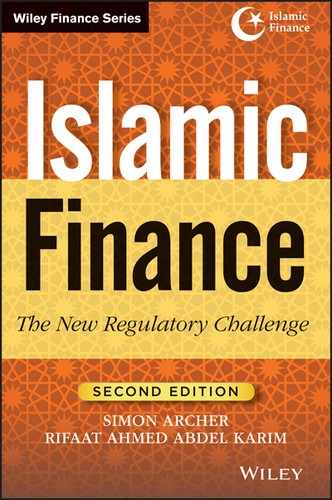Contents
Part One: The Nature of Risks in Islamic Banking
Chapter 1: Supervision of Islamic Banks: The Regulatory Challenge—Basel II and Basel III
2. The Structure of Basel II and Basel III: Supervisory Implications
3. The Islamic Financial Services Board
Chapter 2: Banking and the Risk Environment
1. The Global Risk Environment
3. The Implementation Environment (Setting Up a Risk Management Framework in a Bank)
4. The Future Risk Environment
5. Islamic Banks and the Risk and Regulation Environment
3. Types of Risks in Islamic Finance and Their Measurement
4. Overall Risk of an Islamic Bank and Approaches to Risk Mitigation
5. Summary and Policy Conclusions
Chapter 4: Risk in a Turbulent World: Insights from Islamic Finance
4. The Fundamental Law of Risk
6. Functions of Risk in Islamic Finance
7. Risk Exchange in Islamic Finance
Chapter 5: Capital Structure and Risk in Islamic Financial Services
2. Risk and Capital Structure in Islamic Banks
3. Risk and Capital Structure in Takaful (Islamic Insurance) Undertakings
Chapter 6: Inherent Risk: Credit and Market Risks
3. Inherent Risks in Shari’ah-Compliant Products and Services
Chapter 7: Operational Risk Exposures of Islamic Banks
2. Basel III Requirements and Their Implications for Operational Risk Management
3. Operational Risk: The Basel Methodology
4. Operational Risk in Islamic Banks
5. Unique Operational Risks of Islamic Financing/Investment Modes
Chapter 8: Information Technology Risks in Islamic Banks
2. Important Understandings and Facts
3. ITS Operational Risk—Business, Documentation, and Legal Issues
4. Technical and Functional Clarification for the Imposed Risks
Chapter 9: Law and Islamic Finance: An Interactive Analysis
2. Islamic Jurisprudence in Modern Times
3. Enforceability of the Shari’ah
4. Enforceability of the Shari’ah: Case Law and Transactional Practice
5. Transactional Practice: Legal Opinions
6. Sukuk: Capital Markets and Secondary Markets
Chapter 10: Legal Risk Exposure in Islamic Finance
3. Greater Risk from Uncertain and Undeveloped Law and Regulation
4. Greater Risk from Poor Documentation
5. Greater Risk from Unpredictable Dispute Resolution Processes
Chapter 11: Shari’ah–Non-compliance Risk
2. Risk from an Islamic Perspective
3. The Concept of Shari’ah Compliance
4. Shari’ah–Non-compliance Risk and Its Impact
5. Dealing with Shari’ah–Non-compliance Risk
6. Measuring Shari’ah–Non-compliance Risk
8. Rectification of a Shari’ah–Non-compliant Contract
9. Mitigation of Shari’ah–Non-compliance Risk
Chapter 12: Supervisory Implications for Islamic Finance: Post-Crisis Environment
3. Lessons of the Crisis and Regulatory Responses
Chapter 13: Risk and the Need for Capital
2. The Evolution of International Capital Standards
3. The Risk-Based Financial Regulation Approach
4. Globalisation of Financial Regulation?
5. The Short-Lived Rise of Contingent Capital Instruments
Chapter 14: Measuring Risk for Capital Adequacy: The Issue of Profit-Sharing Investment Accounts
3. Application to Islamic Banks
4. Pillar 2 of the Revised Framework and Risk Management
Chapter 15: Measuring Operational Risk
2. Operational Risk in the Context of Islamic Banks
3. Operational Risk Capital under Basel II
4. Operational Risk Capital under the IFSB Standard
5. Industry Practice and Implementation Issues for Operational Risk Measurement
2. The Regulatory Response to Liquidity Risk
4. Trade Finance Assets as Liquidity
5. Government Bonds and Liquidity
6. Asset-Based Financings and Liquidity
7. The International Islamic Liquidity Management Corporation (IILM)
8. Liabilities (Deposits) as Liquidity
9. Accounting for Liquidity and Fair Value
10. Islamic Banks and the Basel III Liquidity Measures
Part Three: Securitisation and Capital Markets
Chapter 17: Securitisation in Islamic Finance
1. Preface: An Overview of the Sukuk Market
2. Securitisation and Sukuk: Some General Remarks
3. Market for Securitisation in Islamic Finance
6. Securitisation: A Growth Driver for Islamic Finance
Chapter 18: The Role of Capital Markets in Providing Shari’ah-Compliant Liquidity
1. Liquidity and Its Importance to the Islamic Financial System
2. Traditional Role of Capital Markets in Providing Liquidity to Financial Systems
3. Capital Markets—Structure and Analysis
4. Role of Islamic Capital Markets in Providing Liquidity
5. Enhancements to the Critical Dimensions of ICM to Improve Its Ability to Provide Liquidity
10. Current Trends and Work in Progress
Chapter 19: Regulating the Islamic Capital Market
2. The Applicability of Universal Principles of Securities Regulation
3. Approaches to Regulating ICM
4. The Shari’ah Governance Framework
Part Four: Corporate Governance and Human Resources
Chapter 20: Corporate Governance and Supervision: From Basel II to Basel III
1. Introduction: Corporate Governance and the Special Case of Banks
2. Regulation and the Corporate Governance of Listed Companies
3. Basel Pillar 2 and Corporate Governance in Banks
Chapter 21: Specific Corporate Governance Issues in Islamic Banks
2. Salient Characteristics of Islamic Banks
3. Corporate Governance Issues in Islamic Banks
4. Exercising Effective Market Discipline on Islamic Banks
5. Regulation of Islamic Banks
Chapter 22: Transparency and Market Discipline: Post–Basel Pillar 3
3. Transparency and Market Discipline: Specificities of Islamic Finance
2. Recruitment, Retention, and Qualification of Personnel
3. Support Infrastructure for Islamic Financial Institutions
Chapter 24: Concluding Remarks
2. The Challenge to Financial Sector Industry Regulators and Supervisors
3. The Challenge to the Islamic Financial Services Industry Sector
